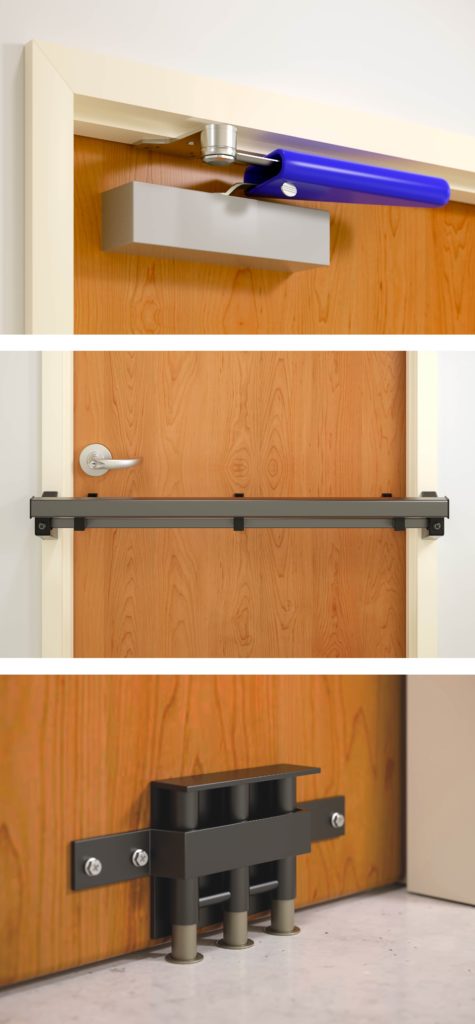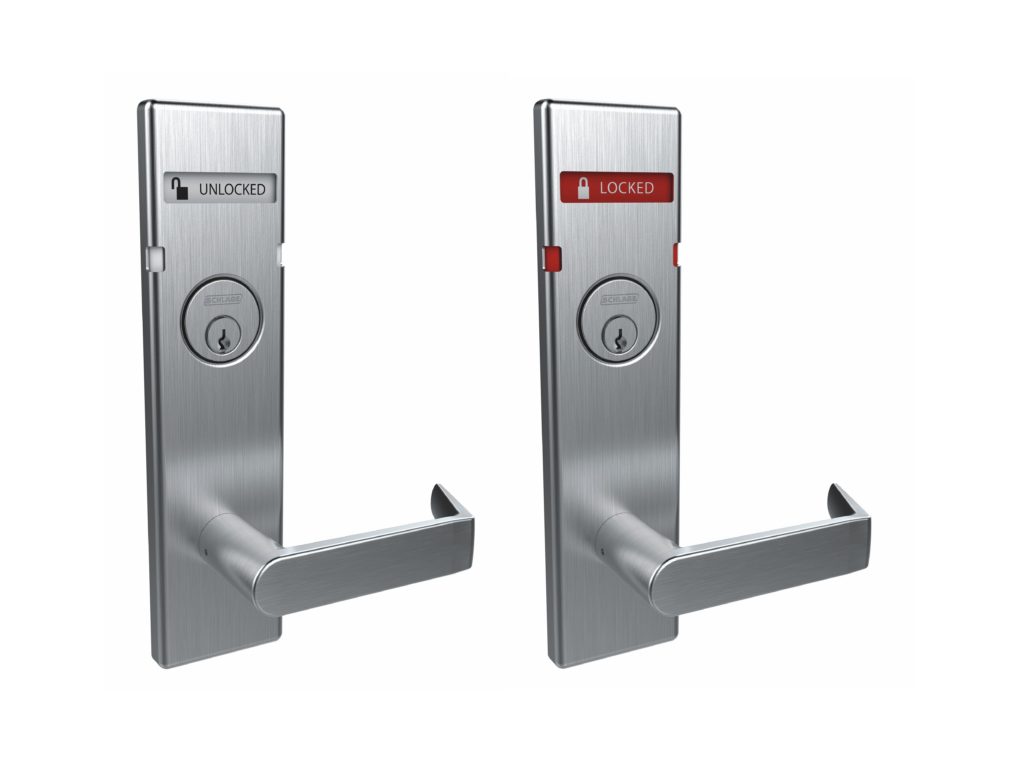This post was published in Door Security + Safety

Classroom barricade devices may seem appealing at first glance, but further consideration reveals life-safety concerns.
In recent years, dozens of retrofit security devices have entered the market with promises of being less expensive, more secure, and easier to procure and install than traditional security hardware. Considering the immediate need to address classroom security – often within tight budgetary constraints – these retrofit products may seem like the answer school administrators have been searching for. But it’s crucial that all aspects of the available security products are considered when evaluating potential solutions. What might initially appear to be a cost-effective way to secure classroom doors may have negative impacts on life safety, fire protection, accessibility, and protection from internal threats.
Traditional locksets which meet the requirements of the model codes are readily available; in fact, most classroom doors are already equipped with locksets. These locks provide the necessary level of security AND allow free egress and evacuation, are certified for use on fire door assemblies, and are compliant with the standards of the Americans With Disabilities Act (ADA). Compliance with these requirements is part of the duty of care that is the responsibility of each school district, and relying on untested security methods that can be deployed by an unauthorized person could increase a district’s risk and liability. So why are some school districts considering expenditures of tens of thousands – even hundreds of thousands of dollars to purchase retrofit security devices, especially if their classroom doors already have locksets?
School Security Misconceptions
There are several inaccurate perceptions that may contribute to hasty decisions when evaluating classroom security methods:
- The belief that mass school shootings are a common occurrence and all schools are under immediate threat. In reality, according to James Alan Fox and Emma E. Fridel (The Three R’s of School Shootings: Risk, Readiness, and Response), mass school shootings are incredibly rare events. Their research found that on average, a total of 20 to 30 mass murders occur per year, and typically one of those incidents takes place at a school. Of course, every school shooting is tragic and everything possible should be done to prevent these events from happening. But the news media has influenced our perception of school violence, and social media amplifies the headlines – some of which are misleading. The news of 18 school shootings in the first 6 weeks of 2018 was repeated millions of times by news sources, public figures, and the general public. This gave the impression that school shootings were occurring multiple times each week, when only 3 of the 18 reported incidents involved multiple gunshots and resulted in deaths or injuries inside of a school. This does not diminish the importance of those 3 shootings, but rushed decisions made while feeling “under attack” may not result in the best long-term solutions. It’s best to take the time needed for careful consideration rather than purchasing devices which might seem like a quick solution but may instead lead to a false sense of security.
- The push to prioritize security over mitigation of other hazards. Although active-shooter events are statistically much less likely to occur than other potential hazards, many parents, students, and school staff members place security concerns at the top of their list. But school administrators must also consider hazards such as weather-related emergencies including windstorm events, fires and bomb threats, incidents related to drugs, alcohol, and mental health issues, suicide, bullying, fights and other non-fatal victimizations. The model codes adopted in most jurisdictions across the US require doors in a means of egress to allow immediate evacuation with one operation to unlatch the door.* This helps to ensure free egress regardless of the type of hazard that is occurring. Some situations, particularly assaults and other non-fatal victimizations, can also be impacted by unauthorized lockdown. When a classroom barricade device is used by an unauthorized person to secure a classroom and commit a crime, a school district may be held responsible because their duty of care has not been met. Even in states where legislators or code officials have modified state codes to reduce the cost of security by allowing classroom barricade devices, a school district may be exposing itself to the possibility of a lawsuit if those devices are used to impede egress.
- The tendency to focus only on intruders and shootings, without considering internal threats and nonfatal victimizations. According to the 2019 Indicators of School Crime and Safety, published by the National Center for Education Statistics, “In 2018, among students ages 12–18, there were about 836,100 nonfatal victimizations (theft and violent victimization) at school.” The same report states that during the 2016-2017 school year, there were a total of 42 school-associated violent deaths with 18 homicides and 6 suicides of students ages 5-18. Again, one student death is one too many, but these statistics give perspective to the situation; the risk of nonfatal victimization is much higher than the potential for an active shooter to enter a school. As the Door Security & Safety Foundation noted in its publication on the liability of classroom barricades (published on lockdontblock.org): “Storing a barricade device in a classroom makes crimes easier to carry out. When used by an unauthorized person, barricades have the significant potential to facilitate unintended consequences such as bullying, harassment, or physical violence. According to the Centers for Disease Control and Prevention (CDC) and the FBI, a member of the student body is most likely to commit violence on school grounds.” Focusing only on protection against intruders without considering the misuse of devices intended to provide security increases risk and liability.
- The idea that traditional locks are not secure enough (ie. the intruder will “shoot the lock off”). Although this happens in movies, it has not been documented in a school shooting. The Final Report of the Sandy Hook Advisory Commission states: “The testimony and other evidence presented to the Commission reveals that there has never been an event in which an active shooter breached a locked classroom door.” I have never heard of a classroom lock forcibly breached by an active shooter – before the shooting at Sandy Hook or in the years since. Unfortunately, there have been several cases where first responders had to breach a classroom door by force because a perpetrator had barricaded himself inside with hostages. Traditional locks provide the necessary level of security for classrooms, and there is a wide range of security products available to secure and monitor exterior doors and compartmentalize a building to limit access from one area to another. All of this can be accomplished without ignoring model codes and state or federal laws.
Model Code Update
During the code development cycle for the 2018 model codes, the issue of how schools can enhance classroom security without compromising life safety was discussed and debated at length. Stakeholders asked, should existing code requirements be relaxed in order to allow less expensive security devices to be installed? Should the requirements remain as-is, or should additional mandates be included in the model codes?
Fortunately, the outcome of this code development process was an overwhelming decision to not only maintain the existing egress requirements for classroom doors, but to add an additional safety mandate. The 2018 editions of the International Building Code (IBC), the International Fire Code (IFC), and NFPA 101 – The Life Safety Code include the following requirements for classroom doors:
- Egress doors must be unlatched by one releasing operation from the egress side. Hardware used to release the latch(es) must be mounted between 34 inches and 48 inches above the floor. One operation must release all latches simultaneously – the model codes do not allow separate operations to release each individual security device.*
- Operation of the hardware for egress must be accomplished without tight grasping, pinching, or twisting of the wrist, and without the use of a key, tool, special knowledge, or effort. Whether the lock is electrified or mechanical, it must allow free egress from the classroom side of the door.
- Locked classroom doors must be able to be unlocked from the outside with a key or other approved means, to allow access for school staff and emergency responders; this is the new requirement that was added to the 2018 model codes.
- Door closers, panic hardware, and fire exit hardware may not be modified by retrofit locking devices, and modifications to fire door assemblies must be in accordance with NFPA 80 – Standard for Fire Doors and Other Opening Protectives.
- The facility’s emergency plan must address the locking and unlocking of classroom doors, and staff must be drilled in these operations.
- In addition, NFPA 101 requires the doors to be lockable from within the classroom, without opening the door.
A classroom security checklist published by the National Association of State Fire Marshals (NASFM) reflects the requirements of the updated model codes and the need for code-compliant security. “The state fire marshals understand the security concerns and the need to protect schools and businesses from senseless acts of violence,” said Jim Narva, executive director of NASFM. “However, some of the proposed solutions may compromise life safety, despite the manufacturers’ good intentions. The NASFM guidelines for classroom security are aligned with the model codes, and underscore the importance of the requirement for new and existing classroom doors to unlatch with one operation, ensuring free and immediate egress. Classroom doors must also meet federal accessibility laws and other requirements of the building codes and fire codes.”
In some jurisdictions, accessibility requirements and the Americans With Disabilities Act (ADA) have been ignored with regard to classroom barricade devices, as the operation of many designs would be beyond the abilities of many occupants with disabilities. Classroom doors nationwide are required to comply with the ADA, so it’s unclear how security products can be used that are in conflict with a federal law. As noted in a letter written to the NFPA Standards Council by Curt Decker, the executive director of the National Disability Rights Network (NDRN), allowing these devices to be utilized in classrooms would be “…discriminatory to those with physical or visual impairments, impedes egress, and is in violation of standards and laws regarding accessibility.”
Locks Save Lives

Traditional locksets are tested and certified to ensure their performance on doors in the means of egress, AND they provide the necessary level of security.
In each school shooting, we learn new lessons about physical security. Many lessons were learned at Columbine High School, including the potential for explosives and fires to be used in a planned attack and the need to address both security and egress. From the shootings at Virginia Tech, Platte Canyon High School, and West Nickel Mines Amish Schoolhouse, we learned that when active shooters take hostages and barricade themselves inside with their victims, law enforcement response can be delayed and the number of casualties may increase. From Sandy Hook Elementary School we learned that teachers – including substitute teachers – MUST have the ability to lock their classroom doors quickly; we also learned that the glass adjacent to school entrance doors is a weak point and must be addressed. From Red Lake High School we learned that sidelights and vision lights in classroom doors should have impact-resistant glazing to deter access to the inside lever or touchpad. From Marshall County High School we learned that the ability to evacuate freely may reduce casualties, and from Rancho Tehama Elementary School and Marjory Stoneman Douglas High School we learned that doors secured with traditional locking hardware can delay or prevent an assailant from entering a school or classroom.
Code-Compliant Security
Although the intent of the model codes is perfectly clear, there is more work to be done. Information on the current code requirements must be shared with school administrators, code officials, and others involved in school-security decisions. School districts can enhance security by evaluating their existing classroom locking hardware and procedures, distributing keys to all staff including substitute teachers, installing impact-resistant glazing or security film adjacent to door hardware, improving perimeter security by locking and monitoring exterior doors, standardizing visitor protocols, and conducting regular training and drills for students and staff. Many of these best practices are addressed in the Guidelines for School Security published by the Partner Alliance for Safer Schools (PASS).
When making these decisions, considering all of the potential concerns and consequences will help to ensure that safety is not overlooked in the rush to increase security. A reactionary response based on fear can lead to a decision that may have unintended consequences.
* In 2019, a tentative interim amendment to NFPA 101 was approved (TIA-1436), which allows existing classroom doors in K-12 schools to have hardware that requires 2 non-simultaneous releasing operations instead of 1 operation to unlatch the door. This change was retroactively applied to the 2018 edition of NFPA 101, and was carried forward into the 2021 edition. The intent of this modification is to allow a separate deadbolt to be added to an existing classroom door. Because the hardware must meet all of the requirements of the code section, most classroom barricade devices do not comply with the Life Safety Code. Note that the second releasing motion is only allowed for existing classroom doors by NFPA 101-2018 and 2021; the IBC and IFC continue to require one releasing motion to unlatch these doors.
~~~
Lori Greene, DAHC/CDC, FDAI, CCPR, is manager – codes and resources for Allegion. She has worked in the door and hardware industry since 1986, and in her current role she provides support and education on code requirements that apply to door openings. Her website, iDigHardware.com, includes numerous resources such as online training, videos, and a downloadable code reference guide. The site is updated each weekday with new information, and readers can subscribe to receive daily or weekly notifications of new posts. Lori can be reached at lori.greene@allegion.com.

